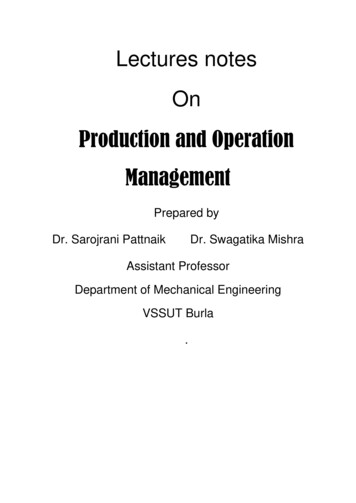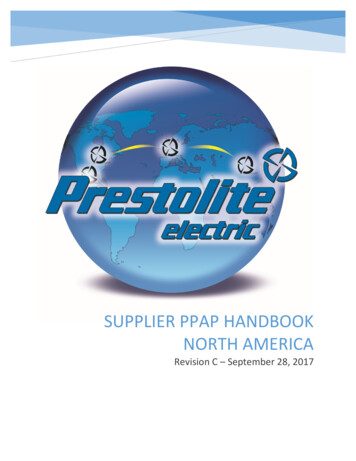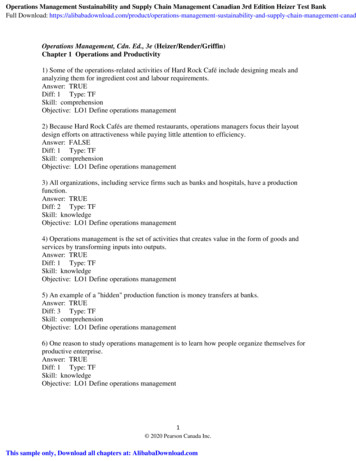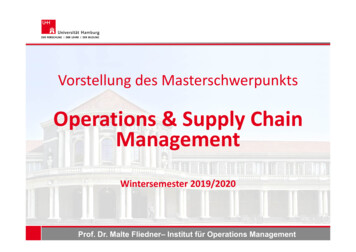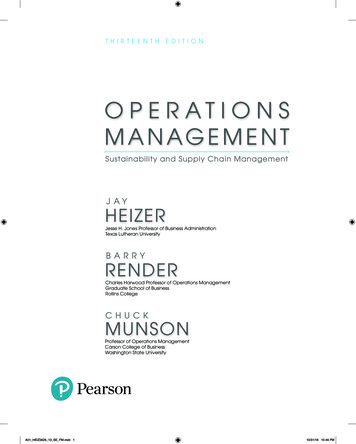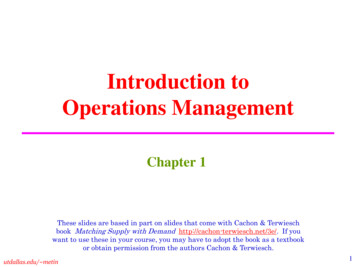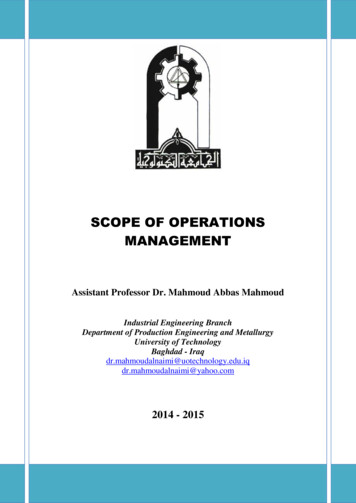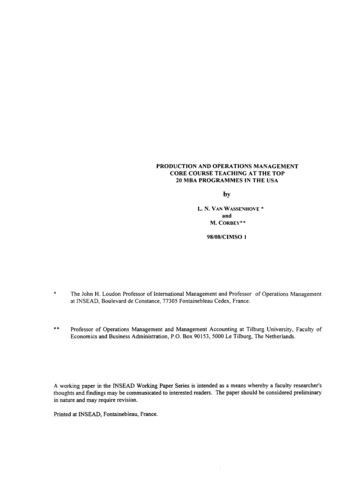
Transcription
PRODUCTION AND OPERATIONS MANAGEMENTCORE COURSE TEACHING AT THE TOP20 MBA PROGRAMMES IN THE USAbyL. N. VAN WASSENHOVE *andM. CORBEY**98/08/CIMSO l***The John H. Loudon Professor of International Management and Professor of Operations Managementat INSEAD, Boulevard de Constance, 77305 Fontainebleau Cedex, France.Professor of Operations Management and Management Accounting at Tilburg University, Faculty ofEconomics and Business Administration, P.O. Box 90153, 5000 Le Tilburg, The Netherlands.A working paper in the INSEAD Working Paper Series is intended as a means whereby a faculty researcher'sthoughts and findings may be communicated to interested readers. The paper should be considered preliminaryin nature and may require revision.Printed at INSEAD, Fontainebleau, France.
PRODUCTION AND OPERATIONS MANAGEMENT CORE COURSETEACHING AT THE TOP 20 MBA PROGRAMMES IN THE USALuk N. Van WASSENHOVE1Michael CORBEY2'N8E- AD. Technolog y Management Area. Boulevard de Constance. 77305 FONTAINEBLEAU Cedcx, France.Telehonc: 33 (0) 1 60 72 40 00. Fax: 33 (0) 1 60 74 55 00/01. E-mail: Luk.Van.Wassenhove@INSEAD.fr.2 TILI3URG University. Faculty of Economics and Business Administration, P.O. Box 90153, 5000 LE TILI3URG. TheNetherlands. Tel: 31 13 466 30 43, Fax: 31 13 466 28 75. E-mail: M.11. Corbey@KUI3.:11. (Visiting 1NSEAD.)
PRODUCTION AND OPERATIONS MANAGEMENT CORE COURSETEACHING AT THE TOP 20 MBA PROGRAMMES IN THE USAAbstractThis paper deals with core course teaching in Production and OperationsManagement (POM) at the Top 20 Business Schools in the USA (as ranked byBusiness Week in 1996). We concentrate on course content (course objectives, splitbetween strategy and tactics, manufacturing and services, and attention paid to newtopic areas) as well as on course delivery (lectures, case studies, factory visits,videos, guest speakers, games and simulations, and other technologies used inteaching POM). Whereas at the end of the 1980s some US authors argued that POMteaching suffered from a positioning problem, our results indicate that there nowappears to be more agreement on what constitutes POM. We also compare ourresults with the situation in Europe and show that there are many similarities butalso some striking differences.
1. IntroductionThis paper deals with core Production and Operations Management (POM) coursesin top US business schools. Apparently, POM teaching is of current interest. Forinstance, the Production and Operations Management Society (POMS) recentlydevoted a two day conference to the subject". A recent literature review is given byGoffin (1996) in his paper on POM teaching in European MBA programmes. Ananalysis of this, and other literature, reveals that there is quite a lot of diversity: some papers deal with teaching POM at the undergraduate level, e.g., Hahn et al.(1984), Hillman and Bass (1989), Levenburg (1996), and Raiszadeh and Ettkin(1989) some papers describe the situation at the end of the 1980's (or even earlier), e.g.,Bahl (1989), Bregman and Flores (1990), Wood and Britney (1990) some papers are relevant for MBA teaching but focus on one subject (e.g.,Quality (Kaplan, 1991)) or one specific delivery method, (e.g., Tunc and Gupta(1995)).Only a few papers deal explicitly with the course content of core POM-MBAcourses. As Goffin (1996) observes:'Several descriptions of core MBA courses at US schools have been providedat conferences [see for instance Donahue [1996], Bowen [1996] and Chand[1996]]. It is noteworthy that no detailed descriptions of European core MBAConference on leaching POM: visions, topics and pedagogies. POMS and the Krannert Graduate School ofManagement. Purdue University, April 1-2, 1996.-3-
courses have been published. (A description of a European core MBA courseand an MBA elective are, however, given in Armistead et al. [1986]).'Goffin's paper investigates course contents in 10 European business schools'. Thecurrent paper, however, addresses POM core course teaching at US businessschools. We decided to concentrate on the top 20 business schools as ranked byBusiness Week in October 1996. This ranking is given in Table 1.In May 1997, POM professors of these 20 schools were asked to provide us with adetailed course outline (syllabus) of their core POM course in the regular 1996-1997MBA programs . After some reminders, we managed to obtain materials from all 20schools. In some cases, additional, explanatory information was requested by Email. In a few cases we failed to secure all the particular details of a course. Inother cases, however, all information could be simply downloaded from the InternetWeb.Our 'methodology' of examining syllabi has potential weaknesses. Syllabi obviouslydo not perfectly reflect classroom reality. Some element may actually be present inthe course but not mentioned as such in the syllabus. For instance, some schoolsexplicitly schedule guest speakers in their course outlines; others may have more orless 'impromptu' guest speaker sessions depending on whether or not the targetedpractitioner happens to be available at the right time. Similarly, the use of videos inthe classroom is not always reflected in the course syllabus. Besides, the syllabi4 Th ese schools have been listed in Appendix 1.5We also sent the POM professors a questionnaire. The results will he published in a separate paper.-4-
sometimes required (subjective) interpretation. Take, for instance, the balancebetween 'manufacturing' and 'services' in a course. We took great care to determinethe relative amount of classroom time devoted to services as opposed tomanufacturing but the distinctions are not always clearcut. In addition, it is of coursepossible that service aspects are discussed in seemingly manufacturing sessions (e.g.,in order to emphasize the differences). However, notwithstanding the obviouspotential weaknesses to our approach, it must be noted that the information in thecourse outlines is by and large representative and perhaps more reliable thaninformation obtained by conducting interviews.Since Goffin has recently reported on the situation in Europe, we decided to followhis approach in order to make a comparison with the USA meaningful. This impliesthat attention is given to the course contents (course descriptions, strategic/tacticalemphasis, manufacturing/service emphasis, existing and new topics/areas to bediscovered) and teaching pedagogies (lectures and case studies, factory visits,videos, guest speakers (practitioners), games and simulations, and other technologiesin teaching POM). Goffin also collected the views of POM professors throughtelephone interviews. We will not deal with opinions in this paper.It must be emphasized that the objective of this paper is not to assess who offers 'thebest' core course in POM (though it would perhaps be wise to do so beforejournalists do it for us.). On the contrary, we are interested in the differencesbetween the USA and Europe as well as in the differences between the US schools.Furthermore, we wish to compare our results with findings from the end of the1980s. By doing so, it becomes possible to observe the progress made on questions5
like the definition of POM, the use of new delivery methods, problems of focus, andrelated matters.2. Overview of coursesFrom each course outline, the following information was derived: duration course objectives focus of the course textboolcs.DurationA large variance can be observed in the US courses. The Virginia course has 40sessions, followed by Harvard (36 sessions), UNC (31 sessions) and NYU andTexas (both 28 sessions). A relative small number of sessions was found at Chicagoand Washington (both 11 sessions), Duke (12 sessions), Michigan (13 sessions) andCarnegie Mellon (14 sessions). On the average, a US POM core course consists of21,4 sessions'. See Table 1 for a complete picture. The figures in this table shouldbe interpreted carefully. They can only serve as an illustration of the variance oftime allocation to POM courses and not as a measure of 'how heavy' the POMcourse is. This stems from the fact that session duration differs (within the coursesand between courses). Furthermore, some schools combine POM courses with othercourses in their curriculum in order to achieve some integration. At Harvard, forinstance, the module New Product Development includes 6 joint sessions with the6We use the word 'session' because most schools do. However. some schools have 'classes' or lectures'.-6-
First-Year Marketing Course. At Michigan, the 13 sessions are followed by amultidisciplinary project ('MAP') that combines Operations Management,Organizational Behaviour, Management Accounting and Information Systems. Still,the variance in time allocation can be considered to be large. This is also the case inEurope: the time allocated to European courses varies from 9 to 38 sessions,according to Goffin (1996).At two schools, the POM core course is divided into two 'mini courses':Pennsylvania has 12 sessions on Operations Management: Quality and Productivityand 12 sessions on Operations Management: Strategy and Technology. AtWashington, there is a 5 sessions course on Operations Policy and Strategy and a 6sessions course on Operations Analysis.Course objectivesGoffin (1996) found that the objectives of the European courses were by and largeequivalent:'Core courses try to show the important role that operations can play inbusiness management, plus cover some of the key concepts, tools, andtechniques.'Our findings indicate that there is no real difference between Europe and the USA.It is, however, interesting to see that some course outlines do not contain explicitlyformulated objectives whereas other outlines elaborate extensively on them. Take,for instance, UNC (Kenan-Flagler):'At the end of the term, each student should be able to:Describe the pervasiveness of operations and recognize key operations activities in his or1.her function, regardless of the organization within which it is found.-7
2.3.4.5.Perform the basic analysis required to understand the operations process, explain how itworks, and perform the necessary calculations to determine capacities at the various stagesof the process.Map out and determine whether a process is appropriate to the needs of the organization andrecommend steps or policies for implementation and improvement.Assess the strategic role of operations for competitive advantage and the appropriatemeasures by which performance is gauged.Assist in implementing a customer oriented approach to running the firm by understandingtotal quality management principles, establishing teams for improving operations, settingappropriate strategic directions for operations and recommending systems for controllingoperations.'Similar comprehensive course (or learning) objectives were found in the syllabi fromPennsylvania, Michigan, Kellogg, Harvard, Virginia, Columbia, Dartmouth, Duke,UCLA, California, Indiana, Carnegie Mellon, and Texas.Focus of the courseWe deal with two important issues here. First, the balance between manufacturingand services and second, the split between strategic and tactical/operational topics.Goffin (1996) found that in many European courses much more emphasis is placedon manufacturing than on service operations. (Course details were reviewed with theteachers who were asked to give percentage estimates.) To be precise: on average66.5 % of course content focuses on manufacturing with a range from 50 to 90 %.Instead of asking the teachers, we examined the course outlines in detail todetermine how much time is actually devoted to services. Using this methodology,we found that the top 20 US business schools place less emphasis on services thantop European schools. On average 89.25 % of time is devoted to manufacturing, witha range from 75% to 100%. The differences may, of course, be caused by the8
different methodology we used. Still, in connection with this, Goffin (1996) madethe following observation:'Most teachers say they aimed to place a higher emphasis on service operationsin the future, in some cases talking about the need for equal emphasis, in termsof examples, cases used, etc. Several stated that their present courses were'still too manufacturing based' and one of the reasons for this, mentioned bythe respondents, is the shortage of case studies based on service operationswhich illustrate operations concepts effectively.'It may be concluded from the above statement that a majority of European POMteachers is at least not happy with the current balance between manufacturing andservices in their courses. In our opinion, Goffin's methodology, asking teachers toestimate the balance, may have caused 'socially desirable responses' . I.e., since ithas been argued in the literature that more weight should be given to services, someteachers may have felt the need to slightly overestimate the attention they actuallypay to services in their courses when interviewed on the matter. Therefore, theactual differences between Europe and the USA may be somewhat smaller than wefound. However, irrespective of the precise percentages of attention paid to servicesin Europe and the US, it is fair to say that the numbers are frighteningly low. Theonly US schools where the syllabi clearly indicate that more than 15 % of the time isspent on discussing service questions are Michigan, Columbia, MIT, UCLA, NYU,UNC, and Texas. Even their percentages do not, in any way, reflect the realities ofthe business world and the importance of services in our modern economies. We canonly conclude that immediate action appears to be called for.9
The second important focus issue is the balance between strategic andtactical/operational topics. Traditionally, POM courses were heavily biased towardsthe use of tools and techniques. Since the beginning of the 1990s, it has been arguedthat the strategic importance of POM should be underlined (Ducharme (1991), Willisand B
PRODUCTION AND OPERATIONS MANAGEMENT CORE COURSE TEACHING AT THE TOP 20 MBA PROGRAMMES IN THE USA by L. N. VAN WASSENHOVE and M. CORBEY 98/08/CIMSO l * The John H. Loudon Professor of International Management and Professor of Operations Management at INSEAD, Boulevard de Constance, 77305 Fontainebleau Cedex, France. ** Professor of Operations

